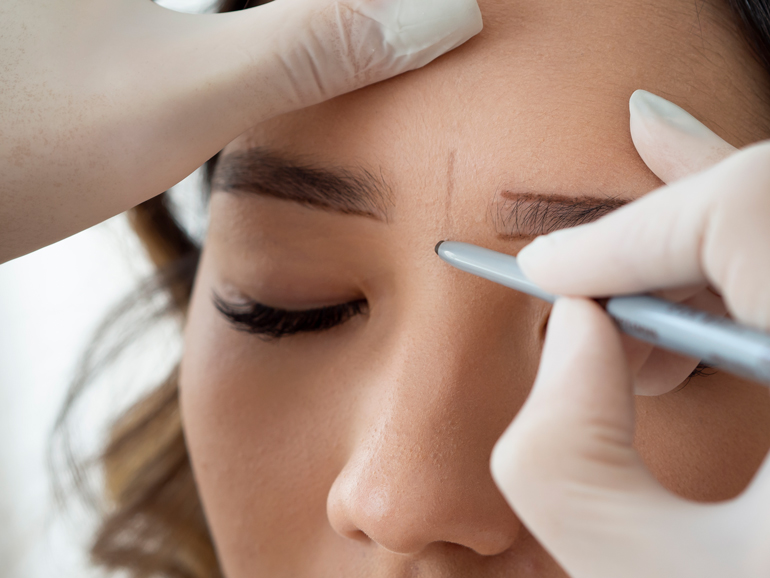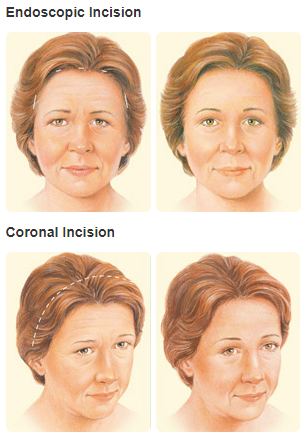Brow Lift in Memphis
As we age, unsightly wrinkle lines may appear on the forehead. Frown lines between the brows can make us look angry or “too serious”. Skin relaxation may cause the eyebrows to drop, hooding our upper eyelids and making us look tired. If you are bothered by these signs of aging in the brow region, a brow lift may be right for you.
A brow lift:
- Reduces the wrinkle lines that develop horizontally across the forehead, as well as those that occur on the bridge of the nose, between the eyes
- Improves frown lines, the vertical creases that develop between the eyebrows
- Raises sagging brows that are hooding the upper eyelids
- Places the eyebrows in an alert and youthful position

Other cosmetic procedures that may be performed with a brow lift include:
- Upper and or lower eyelid tucks
- Facelifting
- Skin resurfacing techniques
You may be a candidate for brow lift surgery if you:
- Are physically healthy
- Don’t smoke
- Have a positive outlook and realistic goals
Consultation and Preparing for Surgery
- Your goals for your appearance
- Your complete medical history
- Your current medications, vitamins, herbal supplements, alcohol, tobacco, and drug use
Your surgeon will also:
- Evaluate your general health status and any risk factors
- Discuss your options
- Examine and measure different parts of your face
- Take photographs
- Recommend a course of treatment
- Discuss likely outcomes of brow lift surgery and any potential complications
Be sure to ask your plastic surgeon questions. It’s very important to understand all aspects of your procedure. It’s natural to feel some anxiety, whether it’s excitement for your anticipated new look or a bit of pre-treatment stress. Don’t be shy about discussing these feelings with your plastic surgeon.
Prior to surgery, you may be asked to:
- Get lab testing or a medical evaluation
- Take certain medications or adjust your current medications
- Stop smoking
- Avoid taking aspirin, anti-inflammatory drugs, and other supplements as they can increase bleeding
Brow lift surgery should be performed in an accredited surgical facility, licensed ambulatory surgical center, or a hospital. You will need to arrange for another adult to drive you to and from surgery, and to stay with you for at least the first night following surgery.
The Procedure

Risks and Safety
The decision to have brow lift surgery is extremely personal. You will have to decide if the surgery will achieve your goals and if the risks and potential complications are acceptable. You will be asked to sign consent forms to ensure that you fully understand the procedure and any risks and potential complications.
The risks include:
- Anesthesia risks
- Bleeding
- Loss of hair around the incisions
- Elevated hairline
- Eye irritation or dryness
- Facial asymmetry
- Facial nerve injury with weakness or paralysis
- Fluid accumulation
- Infection
- Numbness or other changes in skin sensation or intense itching
- Pain, which may persist
- Poor wound healing
- Possibility of revision surgery
- Skin discoloration and swelling
- Skin loss
- Unfavorable scarring
- Rare risk of blood clots
These risks and others will be fully discussed prior to your consent. It’s important that you address all your questions directly with your plastic surgeon.
Recovery After Surgery
When your procedure is completed, your forehead may be taped and your head may be loosely wrapped to minimize swelling and bruising. A thin tube may be present to drain any excess blood or fluid that may collect under the skin. You will be given specific instructions that may include how to care for the surgical site and drains, medications to apply or take orally to aid healing and reduce the potential for infection, specific concerns to look for at the surgical site or in your general health, and when to follow up with your plastic surgeon. You should keep your head elevated and perform no vigorous physical activity for as long as your surgeon recommends. Do not use ice or heat on the operated area.
Be sure to ask your plastic surgeon specific questions about what you can expect during your individual recovery period.
- What medication will I need after surgery?
- Will I have dressings/bandages?
- When will they be removed?
- Are stitches removed? When?
- When can I resume normal activity and exercise?
- When do I return for follow-up care?
Initial wound healing may take 10 to 14 days. Sutures or clips will be removed when it is appropriate. You should be ready to return to work and normal activity after two weeks.
Cosmetics can help camouflage any bruising. Even though you will look presentable to the public, you will find that the healing will continue for several weeks, as the swelling dissipates and incision lines refine and fade. It may take several months for your complete recovery.
Following your physician’s instructions is essential to the success of your surgery. It’s important that the surgical incisions are not subjected to excessive force, swelling, abrasion, or motion during the time of healing. Your doctor will give you specific instructions on how to care for yourself.
Results
The results of your brow lift surgery are immediately visible. Over time, post-surgical swelling will resolve and incision lines will fade. Satisfaction with your new image should continue to grow as you recover from surgery. The final results of your surgery will appear over the next few months.
Although good results are expected from your procedure, there is no guarantee.
Life-long sun protection will help to maintain your rejuvenated appearance by minimizing sun damage. A healthy lifestyle will also help extend the results of your rejuvenated, more youthful appearance.
Robert Wallace MD
“Dr. Robert D. Wallace has been recognized for many years as one of the best plastic surgeons in the United States and has an international reputation for his work in craniofacial, cleft, and cosmetic surgery. He has been on Castle Connelly’s Top Doc list and Best Doctors award for many consecutive years. In addition, he was selected by Newsweek magazine in 2021 and 2022 as one of the top 100 plastic surgeons in the USA on their list for facelift and rhinoplasty surgery. In 2022 he was honored by Memphis Business Journal with the Healthcare Hero award in the physician category for his work in pediatric and craniofacial surgery. He has published multiple medical articles and book chapters in plastic surgery literature.”

Get In Touch
If you have any questions or want to schedule an appointment, contact us and our team will be glad to support you